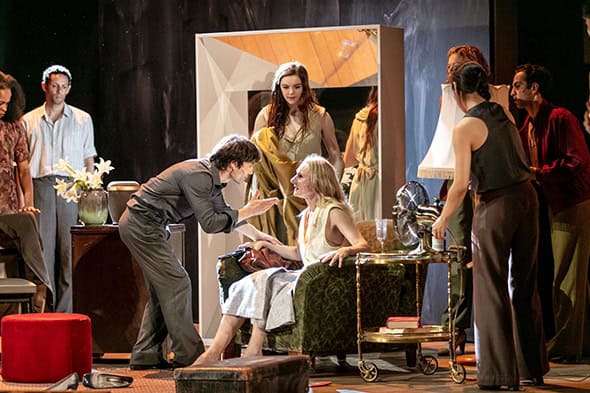Tanztheater Wuppertal Pina Bausch in Bon Voyage, Bob… at Sadler’s Wells
Posted: February 24th, 2019 | Author: Nicholas Minns & Caterina Albano | Filed under: Performance | Tags: Alan Lucien Øyen, Alex Eales, Andrey Berezin, Bon Voyage Bob..., Çaǧdaş Ermis, Dimitris Papaioannou, Héléna Pikon, Pina Bausch, Stephanie Troyak, Tanztheater Wuppertal Pina Bausch | Comments Off on Tanztheater Wuppertal Pina Bausch in Bon Voyage, Bob… at Sadler’s WellsTanztheater Wuppertal Pina Bausch: Bon Voyage, Bob…, Sadler’s Wells, February 22

The two full-length works created last year on Pina Bausch’s company by choreographers Dimitris Papaioannou and Alan Lucien Øyen and presented recently at Sadler’s Wells mark a watershed in the company’s post-Bausch existence. Bausch died in June 2009 and while both the current works deal with her death they do so in inverse ways. In Since She Papaioannou creates a memorial to Bausch in which his half of the company (each choreographer has a cast of sixteen dancers) is working with him from the outside looking in. By contrast in Bon Voyage, Bob… Øyen has created a memorial in which his half of the company is still very much on the inside looking out. There is a clear sense that ten years after her sudden disappearance Papaioannou and Øyen have each allowed the company to publicly commemorate Bausch in works she has not authored, but their respective creative approach suggests that closure for the entire company has not yet been realised.
Øyen accepted without hesitation the invitation to choreograph a new piece for the company as a once-in-a-lifetime opportunity. He knew Bausch’s work mostly through videos, and had only seen the company perform seven years after the choreographer’s death but, as Sarah Crompton observes in the program, his creative approach turned out to be close to Bausch’s own method of gathering material from the dancers and slowly weaving their different narratives into a work. Bon Voyage, Bob… is thus uncannily Bauschian in its shape and vocabulary, with her characteristic intersection of theatre and dance — so much so that Øyen’s cast gives the appearance of having choreographed much of the work themselves. Its form resembles a long psychoanalytical session in which the dancers replay the past in the present with an overwhelming sense of resignation; dreams fail to realize because ‘they have already been dreamt’.
Alex Eales’ set is designed as the backstage area of an unseen work (presumably by Bausch) whose scenes revolve to be used as the backdrop to the company’s own existential drama; it is as if Bon Voyage, Bob… comes together whenever the dancers happen to be off stage. Andrey Berezin is the psychoanalyst in the first scene firing questions at Héléna Pikon sitting across from him at a table recounting the death of her brother. Throughout there is a feeling of guilt, helplessness, and disquiet as memories of dead brothers, dead fathers, and stories of loss become the displaced tropes of Bausch’s own death. Øyen structures the work as a linked ritual of obsequies that allows each of the sixteen dancers to express their feelings in solos of either verbal narrative or movement. It is especially poignant to see the older members of the company speaking Bausch’s gestures naturally through their bodies while the younger dancers who never knew her, such as Çaǧdaş Ermis and Stephanie Troyak, absorb them with stunning eloquence.
However the ‘work’ of mourning that Bon Voyage, Bob… represents does not seem to have enabled what, in psychoanalytic terms, would be a ‘working through’ the suffering that can lead to new levels of freedom and expression. When Rainer Behr angrily assembles a pile of chairs shouting, ‘This is all our shit!’, the depth of pain ten years after the event is heartbreakingly palpable, but it is also clear how far Øyen has retreated from this deeply personal outpouring. And as if three hours of saying goodbye is not enough to make the point, he allows an empty chair to remain in the spotlight as the curtain falls around which the company reassembles for the bows.
The works of Papaioannou and Øyen leave us inevitably with questions about the current state of the company and how it will proceed. Papaioannou suggests a way forward with the creative adoption of Bausch’s incredible legacy of dancers in alternative forms, while Øyen offers a solution that too easily resembles the former company in a new theatrical image. While it is impossible to know what Bausch would have wanted for her company after her death, it is doubtful she would have wished for it to be trapped in forever looking back; and yet her legacy is so intimately related to her works that finding a way forward without her is still fraught with challenges.